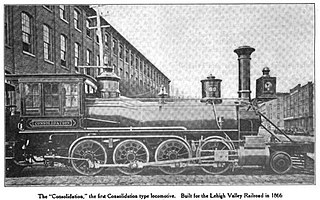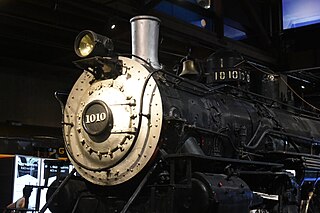
A 2-8-8-4 steam locomotive, under the Whyte notation, has two leading wheels, two sets of eight driving wheels, and a four-wheel trailing truck. The type was generally named the Yellowstone, a name given it by the first owner, the Northern Pacific Railway, whose lines ran near Yellowstone National Park. Seventy-two Yellowstone-type locomotives were built for four U.S. railroads.

Under the Whyte notation for the classification of steam locomotives, 4-8-4 represents the wheel arrangement of four leading wheels on two axles, eight powered and coupled driving wheels on four axles and four trailing wheels on two axles. The type was first used by the Northern Pacific Railway, and initially named the Northern Pacific, but railfans and railroad employees have shortened the name since its introduction. It is most-commonly known as a Northern.

The Chicago, Burlington and Quincy Railroad was a railroad that operated in the Midwestern United States. Commonly referred to as the Burlington Route, the Burlington, or as the Q, it operated extensive trackage in the states of Colorado, Illinois, Iowa, Missouri, Nebraska, Wisconsin, Wyoming, and also in Texas through subsidiaries Colorado and Southern Railway, Fort Worth and Denver Railway, and Burlington-Rock Island Railroad. Its primary connections included Chicago, Minneapolis–Saint Paul, St. Louis, Kansas City, and Denver. Because of this extensive trackage in the midwest and mountain states, the railroad used the advertising slogans "Everywhere West", "Way of the Zephyrs", and "The Way West".

The EMD FP45 is a cowl unit type of C-C diesel locomotive produced in the United States by General Motors Electro-Motive Division (EMD). It was produced beginning in 1967 at the request of the Atchison, Topeka and Santa Fe Railway, which did not want its prestigious Super Chief/El Capitan and other passenger trains pulled by freight style hood unit locomotives, which have external walkways.

Under the Whyte notation for the classification of steam locomotives, 2-8-0 represents the wheel arrangement of two leading wheels on one axle, usually in a leading truck, eight powered and coupled driving wheels on four axles, and no trailing wheels. In the United States and elsewhere, this wheel arrangement is commonly known as a Consolidation, after the Lehigh and Mahanoy Railroad’s Consolidation, the name of the first 2-8-0.

The EMD SD9 is a model of diesel locomotive built by General Motors Electro-Motive Division between January 1954 and June 1959. An EMD 567C 16-cylinder engine generated 1,750 horsepower (1.30 MW). Externally similar to its predecessor, the SD7, the SD9 was built with the improved and much more maintainable 567C engine.

The SD45 is a six-axle diesel-electric locomotive class built by General Motors Electro-Motive Division between 1965 and 1971. It has an EMD 645E3 twenty-cylinder engine generating 3,600 hp (2,680 kW) on the same frame as the SD38, SD39, SD40, and SDP40. As of 2023, most SD45s have been retired, scrapped or rebuilt to SD40-2 standards.

Reading 2101 is a preserved American class "T-1" 4-8-4 "Northern" type steam locomotive constructed in September 1945 for use by the Reading Company. Constructed from an earlier "I10SA" 2-8-0 "Consolidation"-type locomotive built in March 1923, the 2101 handled heavy coal train traffic for the Reading until being retired from revenue service in 1959. Withheld from scrapping, the 2101 served as emergency backup power for the three other T1 locomotives serving the Reading's "Iron Horse Rambles" excursions until being sold for scrap in 1964.

Spokane, Portland & Seattle 700 is the oldest and only surviving example of the class "E-1" 4-8-4 "Northern" type steam locomotive and the only surviving "original" Spokane, Portland and Seattle Railway steam locomotive. It was built by the Baldwin Locomotive Works in May 1938. Nearly identical to the class "A-3" Northerns built for Northern Pacific Railway, it burns oil instead of coal.

Atchison, Topeka and Santa Fe Railway No. 1010 is a 2-6-2 type steam locomotive built by the Baldwin Locomotive Works in 1901 for Atchison, Topeka and Santa Fe Railway. It started out as a Vauclain compound locomotive before it was rebuilt into a conventional locomotive in the 1910s. It was primarily used for various passenger trains across the Southwestern United States, including the record breaking 1905 Scott Special on the segment between Needles, California, and Seligman, Arizona, before it was reassigned to freight service in the 1940s. It was retired in 1955 and was kept by the Santa Fe for several years for preservation purposes. In 1979, Santa Fe donated No. 1010 to the California State Railroad Museum, where the locomotive resides there in Sacramento as of 2023.

Canadian National 3254 is a class "S-1-b" 2-8-2 "Mikado" type steam locomotive built by the Canadian Locomotive Company for the Canadian National Railway as the fifth member of the Canadian National class S-1-b.

The Reading T-1 was a class of 4-8-4 "Northern" type steam locomotives owned by the Reading Company. They were rebuilt from thirty "I-10sa" class 2-8-0 "Consolidation" type locomotives between 1945 and 1947. Out of the thirty rebuilt, four survive in preservation today, those being numbers 2100, 2101, 2102, and 2124.

The Great Northern S-2 was a class of 14 4-8-4 "Northern" type steam locomotives built by the Baldwin Locomotive Works in 1930 and operated by the Great Northern Railway until the late 1950s.
The Great Northern O-1 was a class of 145 2-8-2 "Mikado"-type steam locomotives built by the Baldwin Locomotive Works between 1911 and 1919 and used by the Great Northern Railway until the late 1950s.
The Great Northern S-1 was a class of 6 4-8-4 Northern type steam locomotives built by the Baldwin Locomotive Works in 1929 and operated by the Great Northern Railway until the late 1950s. They were initially put in passenger service but eventually saw service pulling freight.

The Great Northern H-5 was a class of 25 4-6-2 "Pacific" type steam locomotives that were originally built as E-14 4-6-0 "Ten Wheelers" by the Baldwin Locomotive Works in 1909 and operated by the Great Northern Railway until the mid-1950s.

Lake Superior and Ishpeming Railroad No. 18 is an SC-4 class 2-8-0 “Consolidation” type steam locomotive, built by ALCO’s Pittsburgh Works in 1910 for the Lake Superior and Ishpeming (LS&I) Railroad in Upper Michigan. Originally numbered 11, the locomotive was renumbered to 18 in 1924, and it served the railroad, until it discontinued steam operations in 1962. No. 18 was subsequently sold to the Marquette and Huron Mountain tourist railroad, where it was put into storage alongside other steam locomotives.

Reading Blue Mountain and Northern Railroad 2102 is a preserved "T-1" 4-8-4 "Northern" type steam locomotive. Originally built by the Baldwin Locomotive Works in March 1925 as an "I-10sa" 2-8-0 "Consolidation" type locomotive for the Reading Company, No. 2102 was rebuilt by the Reading's own locomotive Shops as a 4-8-4 "Northern" in September 1945, and it was used for pulling heavy coal trains for the railroad until being retired from revenue service in 1956. Between 1962 and 1964, No. 2102 was used to pull the famous Iron Horse Rambles excursion trains. After the Rambles ended in 1964, No. 2102 was sold to Steam Tours Inc. of Akron, Ohio to spend the next 23 years pulling various fan trips in the Northeast, Mid-Atlantic and Midwest. In 1985, it was sold again to Andy Muller to operate on his Reading Blue Mountain and Northern Railroad alongside 4-6-2 "Pacific" No. 425, until its flue ticket expired in 1991. Beginning in February 2016, the locomotive was restored to operating condition and returned to service in April 2022.

Reading 2100 is the prototype of the T-1 class 4-8-4 "Northern" type steam locomotives constructed in September 1945 for use by the Reading Company (RDG). Constructed from an earlier 2-8-0 "Consolidation" type locomotive built in May 1923 by the Baldwin Locomotive Works, No. 2100 pulled heavy freight and coal trains for the Reading until being retired from revenue service in 1956. Between 1961 and 1964, No. 2100 was used to pull the RDG's Iron Horse Rambles excursions alongside fellow T-1's Nos. 2124 and 2102. After the rambles ended, No. 2100 was sold along with No. 2101 in 1967 to a scrapyard in Baltimore, Maryland.

Union Pacific 5511 is a 2-10-2 “Santa Fe” type steam locomotive built by the Baldwin Locomotive Works in 1923 as part of the Union Pacific Railroad's TTT-6 class. It is the last remaining member of its class and the only remaining 2-10-2 to be operated by the Union Pacific.

















